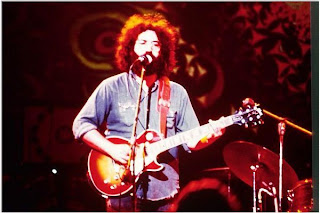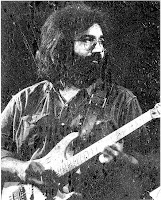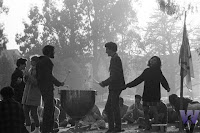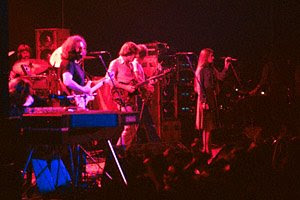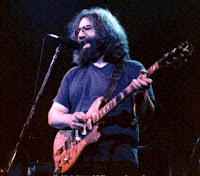Monday, January 22, 1968
Eagle's Auditorium – Seattle, WA
Soundboard Recording
The Grateful Dead were evolving at light speed. Or at least it seems that way. We have so little of the music from 1967 that the little glimpses we get are like spending an hour trying to tune in a radio dial to our favorite station and only hearing it for fractions of a second, a mere handful of times. While those glimpses are all on the same frequency, they actually end up sounding like very different radio stations altogether. In an interesting analogy, it could be said that history has formed 1967 into a mystery not unlike a caterpillar’s metamorphosis into a butterfly. Maybe we aren’t meant to see exactly how it happened?
1968 comes along and the band has clearly evolved into a psychedelic rock band like no other. In this early example of 1968 from Eagle’s Auditorium on January 22nd, we find the band fully defined (and Mickey had only joined the band as drummer number two a scant few months earlier). There could be entire books devoted to the ways in which the Dead differed from the other bands of the same era and genre. I’ll mention only that rather than playing in and on the style of the day, the Dead sounded like they were channeling psychedelic rock from the depths of creation; they were the voice through which the music’s soul chose to express itself – one of the obvious nods to labeling early years as “primal.”
Wasting no time what-so-ever, Alligator flies out of the gate stoking the psychedelic fires. Considering what follows, the song is actually a tad tame. It’s great to listen to the extremely slow dissolve into more and more freaked out music as the song moves along, going from recognizable rock instrumentation into fields of more and more slightly bizarre noises and vibrations . The edges of the song and the music continually fray away from a center of normalcy. Here, with the band taking its time, it seems somehow orchestrated and organic at the same time - improvised music with design. That said, by the end of Alligator, we are barely prepared for the rest of the set.
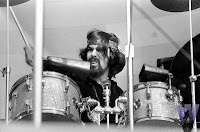 The live recordings used for the Anthem Of The Sun LP come from shows in November ’67 and January ’68. The 01/22/68 Cryptical > Other One > Cryptical suite is very much indicative of the album version with the added pleasure of an extra (first) verse on Other One. As it blossoms into New Potato Caboose it bears mentioning that the crowd was hearing side A of the record before it was released. Having imprinted myself so heavily on this record in the early years of my Dead discovery process, I can barely imagine what experiencing this musical journey might have been like live and fully unprepared.
The live recordings used for the Anthem Of The Sun LP come from shows in November ’67 and January ’68. The 01/22/68 Cryptical > Other One > Cryptical suite is very much indicative of the album version with the added pleasure of an extra (first) verse on Other One. As it blossoms into New Potato Caboose it bears mentioning that the crowd was hearing side A of the record before it was released. Having imprinted myself so heavily on this record in the early years of my Dead discovery process, I can barely imagine what experiencing this musical journey might have been like live and fully unprepared.As New Potato expands out into its post song jam section I can’t help but marvel at the small section of music before Jerry starts truly soloing. It’s the window of music that features nothing more than the sound of psychedelic winds blowing lazily around. This portion of the song where it seems almost nothing is happening (Jerry’s volume knob work layered over the band’s primal rhythm section churn) is magic for me. The sense of levitation is addictive. Short lived, it moves into the pure embodiment of the New Potato Caboose Groove. Here, there is a pervasive sensation of a glorious army march cresting over hilltops bathed in rainbow-hued sunshine. As they move into the melodically designed end portion of the song you can’t help but be completely locked in step with the band. It’s a song your heart already knows how to sing.
Instantly we drop on queue into Born Cross-Eyed, which comes off as some sort of twisted AM radio top 40 hit. This song seems to break as many rules as you’ll let it. And then the song ends and takes us beyond its spot as the last song on side A of the record, past the center groove of the LP, into a drippingly dark Feedback segment peppered with teases of the Spanish Jam lurking some four minutes in the future. Before getting there, we’re left with no place to hide from a restrained freefall into chaos. The Feedback is brooding and black, like wet rocks underground prevented from seeing sunlight. Darkness without fear, it’s more haunting than scary. Spanish Jam appears and provides a twisted pathway out of the formless void in which it found us.
 Then Dark Star. Not the epic it would become one year later – this song would need quite some time to breath – this is a none-the-less lovely version. Jerry’s solo lines are delivered with a familiar lilting. Still played faster than could allow the song’s phenomenal power to full take effect, there is nothing not to like about this early version. The band is clearly letting the song come to life and take form. They feed it whatever feels right. There’s a sense that an artist is taking another few minute pass at carving a statue out of rock. And then at the spot that would eventually head into the yet to be introduced St. Stephen, we go perfectly into China Cat Sunflower.
Then Dark Star. Not the epic it would become one year later – this song would need quite some time to breath – this is a none-the-less lovely version. Jerry’s solo lines are delivered with a familiar lilting. Still played faster than could allow the song’s phenomenal power to full take effect, there is nothing not to like about this early version. The band is clearly letting the song come to life and take form. They feed it whatever feels right. There’s a sense that an artist is taking another few minute pass at carving a statue out of rock. And then at the spot that would eventually head into the yet to be introduced St. Stephen, we go perfectly into China Cat Sunflower.These early early China Cats are sensational. You can easily hear how the song places the band directly back into the Alligator jam style, and they are completely comfortable here. To listen to them fly through the song, all playing their finely crafted counterpoints with such energy, is primal Dead joy. When Jerry blasts into the last solo which heads toward The Eleven, it’s like fireworks exploding overhead. When they hit The Eleven proper it is clear that they have spent the last couple of months with Mickey in the band practicing this 11/8 time signature a lot (as the story certainly goes). After a slight passage where Jerry seems to regroup, the nectar begins to flow and flow.
That there are actually vocals in the midst of this music never fails to amaze me. Regardless of it still being a somewhat early version (one of the very first we know of on tape) there is nothing timid going on here. Interestingly, they don’t linger. Things cool down, and with one of Jerry’s magician-like casting of a rainbow full of notes, we are in Caution.
There wasn’t much in the Dead’s repertoire that contained more raw power. What the band had been doing with Viola Lee Blues, they continued to develop in Caution, and you could completely see how it provided the same outlet, only slightly more fierce. There was the same amazing juxtaposition of bluegrass to psychedelia. If there’s anything to really mourn on this tape, it’s that the entire vocal portion of this Caution is absent. When the SBD>DAT version made it into circulation, I noticed that it ended early in Caution itself. But I had a cassette version which, after the same cut, picked back up after one second of dead air after the vocals (reel flip?), to play out the rest of the show. I stitched up the version in circulation linked below.
 The slide into Feedback is breathtaking. The portion of the tape that comes after the cut begins with Caution reaching its highest peaks while a pure frenzy of soul smashing noise and energy tears itself apart in a slow motion megaton explosion until nothing is left but a white-hot onslaught of noise. It slowly passes into quiet, leaving the audience completely stunned. There’s nothing left. Then from the emptiness rises the familiar album ending feedback portion from Anthem of the Sun, running a good time longer than the B side of the record could contain.
The slide into Feedback is breathtaking. The portion of the tape that comes after the cut begins with Caution reaching its highest peaks while a pure frenzy of soul smashing noise and energy tears itself apart in a slow motion megaton explosion until nothing is left but a white-hot onslaught of noise. It slowly passes into quiet, leaving the audience completely stunned. There’s nothing left. Then from the emptiness rises the familiar album ending feedback portion from Anthem of the Sun, running a good time longer than the B side of the record could contain.This is wholly mind crippling music culled from the pool in which all mind enlightening satori energy forms. The potency this close to the pool is more than the senses can bear - in a way preventing our ability to feel the gentle expanding release into the moment. Our attention is locked, to be sure, but things are moving and changing so fast and in so many directions, the power becomes overwhelming – as I said, crippling.
A living example of what the older generation surely saw as unbearably wrong with the youth, and yet for those who had made room in their head for it, a nirvana-petal flower calling from the deep soul lifeblood of music. This is what lives at the heart of it all. The rushing, looping, exploding, twisting inferno whose fingers reach their way all the way into every fiber of the Grateful Dead body. Tinged with this magic, it is no wonder so many of us find so much drawing us all the way in time and time again.
01/22/68 SBD etree source info
01/22/68 SBD Stream












